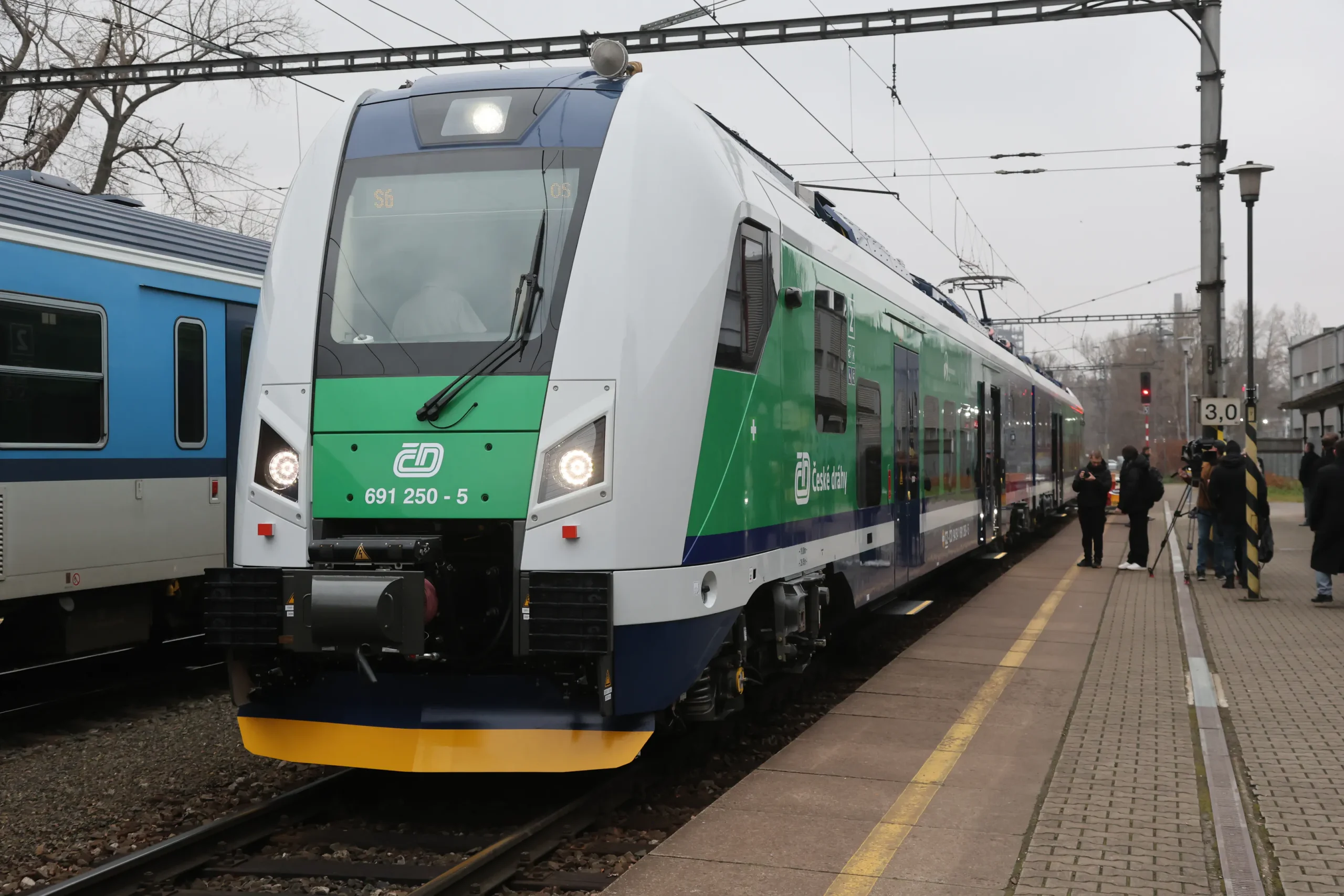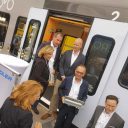Škoda has officially unveiled Czechia’s first battery train, which is already up and running as part of the regional fleet in Moravia-Silesia. Set to help green the country’s semi-electrified regional networks, the new models are based on Škoda’s popular RegioPanters. But how does the company’s first battery train compare to similar offerings from its competitors?
Last weekend, the first Czech battery train from Czech manufacturer Škoda Group was officially presented at Ostrava-střed railway station, an important local transport hub that also happens to be the home of the Moravian-Silesian Railway Museum. And for the region, and the Czech Republic, it is indeed a historic event.
A symbol of a new era on non-electrified lines in Czechia, the battery-run rolling stock first hit the tracks on 15 December, running between Ostrava-střed and the regional rail hub of Frýdek-Místek. It has now officially joined the local fleet, serving the S8 line in the Moravian-Silesian Region since Sunday. It is expected to be followed by another 14 of Škoda’s new battery trains.
 The Czech Minister of Transport Martin Kupka, CEO of Czech Railways (České dráhy, ČD) Michal Krapinec, the regional governor, and the Vice-Chairman of Škoda were all there for the presentation. © Škoda Group
The Czech Minister of Transport Martin Kupka, CEO of Czech Railways (České dráhy, ČD) Michal Krapinec, the regional governor, and the Vice-Chairman of Škoda were all there for the presentation. © Škoda Group
The inauguration of the new train was attended by high-profile guests, including the Czech Minister of Transport Martin Kupka, CEO of Czech Railways (České dráhy, ČD) Michal Krapinec, the regional governor, and the Vice-Chairman of Škoda.
Technological milestone
“Our new battery train is a technological milestone that continues our long tradition of innovation in transport,” said Tomáš Ignačák, Vice-Chairman of the Board of Directors at Škoda Group, as the new train was presented. “Already in the 1930s – at a time when most people were just beginning to think about similar technologies – we produced the first battery locomotive,” he added.
 The interiors offer a boost in passenger comfort. © Škoda Group
The interiors offer a boost in passenger comfort. © Škoda Group
“We have built on these foundations in modern times – from battery-powered trams to trolleybuses to this train. It is another step on the road to environmentally friendly, flexible, and sustainable transport and proof that Czech industry can be at the forefront of innovation.”
Škoda’s battery train is based on the platform of its domestically popular and widely exported RegioPanters and is equipped with advanced LTO batteries, which enable operation on non-electrified lines. The batteries are charged from both the DC and AC mains, with a full charge taking just 25–30 minutes depending on the voltage type. The train can travel up to 80 kilometres on a single charge, reaching speeds of up to 120 km/h when running on battery power and up to 160 km/h on electrified sections.
How does it compare to other battery models?
That makes Škoda’s battery offering more limited than its competitors in terms of technical specs. Its 80-kilometre range is dwarfed by Stadler’s FLIRT Akku, which can achieve 100–150 kilometres, and Alstom’s Coradia Continental BEMU, with a range of approximately 120 kilometres. Meanwhile, Stadler’s and Alstom’s trains can often recharge in around 15–20 minutes, half the time of Škoda’s offering.
 The train can travel up to 80 kilometres on a single charge. © Škoda Group
The train can travel up to 80 kilometres on a single charge. © Škoda Group
In terms of speed and platform, Škoda’s maximum of 120 km/h on battery power and 160 km/h on electrified sections runs slightly slower than Stadler’s FLIRT Akku (140 km/h battery mode), but falls noticeably short of Alstom’s Coradia, which goes up to 160 km/h in battery mode.
While it’s difficult to compare prices, especially considering most contracts cover maintenance, it appears that Škoda’s offer will be significantly cheaper than its competitors. In 2019, Alstom secured a contract to supply 11 Coradia Continental BEMU trains to Verkehrsverbund Mittelsachsen (VMS) in Germany, valued at approximately 100 million euros, suggesting an average price of around 9 million euros per train. Meanwhile, ÖBB’s 2023 order for 16 of Stadler’s FLIRT Akku totalled around 194 million euros, with an average cost of about 12.1 million euros per unit.
 The train will likely be cheaper than comparable models. © Škoda Group
The train will likely be cheaper than comparable models. © Škoda Group
In contrast, Czech Railways contracted Škoda for 15 of its new battery-electric multiple units in Moravia-Silesia for around 151.9 million euros, including a 15-year maintenance clause, meaning the average cost per train unit is approximately 7.6 million euros, a notable price drop. That’s important to ČD at the moment as it is heavily investing in updating its rolling stock.
€6 billion investment
Michal Krapinec, ČD’s Director General, said earlier this year that the company was in a period of “record-breaking investments” in new trains. “This year we will invest almost 20 billion CZK (800 million euros). In the next 10 years we plan to purchase new trains worth more than 160 billion CZK (6.53 billion euros).” Some 140 new electric, diesel and non-traction units and electric locomotives were set to enter the Czech railway network this year – approximately 440 individual vehicles.
“The Czech railway is undergoing a qualitative change, which includes the deployment of modern vehicles on more lines,” said Martin Kupka, Minister of Transport of the Czech Republic at the launch of the new battery trains. “Increasing comfort and reducing journey times is often not possible without electrification. Not everywhere, however, is it possible to electrify the lines in the foreseeable future or, for example, due to the natural environment around the tracks, the power lines cannot be easily located; and this is where there is a place for battery trains.”
Read more:
Want full access? Take advantage of our exclusive offer
Are you already a subscriber?



